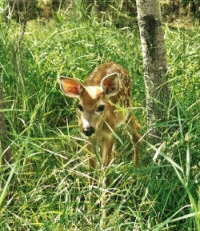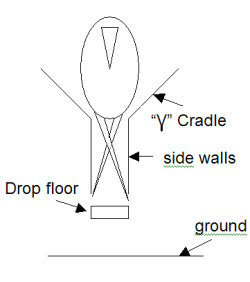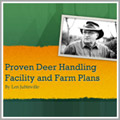Evolution of the DeerhandlerTM
Since 1988
Here at Delclayna we are always looking for ways to improve the lives of deer farmers and their animals. Since the moment he was introduced to deer farming, Leonard Jubinville, founder of Deerstore.com and Delclayna Manufacturing, passionately believed there was a natural, effective and safe way to handle the highly respected and elusive whitetail deer. Len became a deer farmer in St. Albert, Alberta, Canada in 1988. With Alberta's stringent regulations, the ability to restrain deer was a requirement from the beginning. Since Len was involved in extracting deer from the wild to help supply the initial seed stock, his need for safely and effectively restraining the animal was particularly important.
Over the years, the way Len handles deer has evolved considerably. Through trial and error and continuous revision, Len has perfected not only his deer handling practices but also the deer handling equipment he manufactures. When you purchase a DeerhandlerTM, you can rest assured knowing you are purchasing a piece of equipment that has been developed, tested and perfected by a leading innovator in the deer industry who is backed up with 20 years experience in handling whitetail deer safely and effectively without drugs. To demonstrate this fact, included here is a detailed overview of the evolution of the DeerhandlerTM. You will see from Len's experience just how the DeerhandlerTM became the most recognized and respected deer chute on the market today.
The Seed is Planted
Where the desire to develop deer handling equipment took root
In 1994, Len flew to New Orleans to attend a NADeFa convention. It was an informative and impressive convention with many people in attendance but there were hardly any farmers raising whitetail deer. It was a little disappointing for Len to find only a handful of farmers who shared in his enthusiasm for raising whitetails. Nevertheless, he decided to use his time connecting with as many people as he could. Since he was so passionate about farming whitetails, he was curious to find out why more farmers weren't choosing to raise them also.
Not being too shy, he was able to meet many farmers at the convention and each new deer farmer he met he questioned them about why they chose not to farm whitetail deer. He realized everyone either answered that whitetail deer farming was not yet legal in their State or they believed the whitetail deer was impossible to handle. When he asked them to elaborate on why they believed the whitetail deer was so difficult to handle, they all gave a variation on the following answer; "Well, since they are so challenging to hunt, they must be too difficult to handle." Len would then ask if they had ever even tried to handle a whitetail deer and everyone gave a response such as, "Well, no but from my hunting experience, I can just imagine." Having extracted whitetails from the wild and having already successfully handled deer for many years, Len knew the idea whitetail deer couldn't be handled was a myth.
From speaking with so many farmers, Len could now identify a huge stumbling block the whitetail deer farming industry was facing at the time. How could you build an industry around an animal so many people believed was impossible to handle? It was then Len decided to devote his time and energy on developing the right equipment and teaching the proper techniques to handle these animals with the least amount of stress. Len understood that in order to build an industry around an animal, you need to be able to manage them; in order to manage them, you need to be able to handle them and in order to handle them, the right equipment is a necessity.
Len was convinced that if he built the right equipment, he could show others how easy whitetail deer were to handle. Len hoped that by changing people's perceptions about handling these animals, he could help to influence State laws to allow the farming of whitetail deer. He knew he didn't have the power to change State laws himself, but he thought if governments could see that it was possible for farmers to manage these animals and make a viable business out of it, they would eventually be willing to change their laws.
 |
This article is dedicated in memory of our good friend, Adolf Yeske.
Thanks for being there every step of the way. |
Article links:
Before the DeerhandlerTM
Early Version of the DeerhandlerTM
The DeerhandlerTM Today
Before the DeerhandlerTM
Hole in the Box Chute

Handling deer with the Hole in the Box Chute 1988
Even though it was only after his visit to New Orleans that Len decided to make designing the right deer handling equipment his mission, he had already experimented with different types of chutes. For instance, the first chute he tried on his farm was the Hole in the Box chute. The Hole in the Box chute was simply a wooden box with a hole carved out the split head gate mounted at the front of the box.
Len quickly learned this chute had many disadvantages. With this chute, once the gate for entering the chute was opened, the deer in the dark tunnel would see daylight from the hole in the head gate. In most cases, upon seeing daylight, the deer would immediately poke its head through the hole, believing it was a means of escape. It would, however, quickly realize it was not a means of escape and often the deer would pull back and its head would disappear just as quickly as it had appeared. If the operator of the sliding head gate wasn't quick enough, the deer's head would not be restrained and all that would remain was a deer in a box. Trying to put the head through the hole a second time often became an exercise in patience.
Once the operator had successfully closed the head gate in time, the deer's reaction was to continue to try to pull back. As a result, the deer's head would remain still as the operator held it but its body was constantly moving. Eventually, Len built a sliding wall that could be pushed in to apply pressure and squeeze the deer against the solid side of the box in an attempt to hold the deer still but this proved to be only somewhat effective.
Although the Hole in the Box chute was able to hold the deer fairly still, it was extremely limiting. As Len's deer herd grew, so did his patience with the Hole in the Box chute. Only deer without antlers could use it and it provided very little access to the animal. Deer handlers could only access the animal's head and part of its neck. Any other access had to be done through openings in the walls where the deer's legs would often poke through, which was ineffective and unsafe.

Handling fawns was extremely difficult with the Hole in the Box Chute
One of Len's many frustrations with the Hole in the Box chute was the fact that when fawns entered the chute they would often pull back and squat down. The first thing that needs to be determined when dealing with a fawn is its sex. At Delclayna, Len installed a large dangle tag in the left ear for males and in the right ear for females. In the fall, if you can't confirm a fawn has buttons, proving it is a male, you are required to check under the tail to determine sex. If the fawn is sitting down and covering the evidence, what do you do? With the Hole in the Box chute, the operator had to lift the deer in a standing position to access the back end. Since there was nothing between operator and fawn, each time this task needed to be performed there was a chance of getting kicked; not exactly a practical or effective practice.
Another frustrating feature of the Hole in the Box chute was the fact operators were required to work in a crouched position most of the time. Can you imagine having to TB test 500 deer in a crouched position? Not a pleasant undertaking with the Hole in the Box chute.
The Hole in the Box chute may have been helpful for tagging and TB testing, but in order to properly manage deer, there is a lot more a farmer may be required to do such as; DNA sampling, parasite control and cutting or scoring antlers to name a few. A.I.ing (artificially inseminating) does or extracting semen from bucks are also impossible tasks to accomplish with something like the Hole in the Box chute.
Head Gate with Rotunda Chute

Head Gate with Rotunda Chute 1990
It obviously didn’t take long for Len and the Delclayna team to become frustrated with the limitations of the Hole in the Box design. It was quickly replaced with a chute Len created as a cross between a cattle chute, the Hole in the Box chute and a rotunda.
Like the Hole in the Box chute, to prevent deer from jumping around in the box, this model was built only 5 feet high. This obviously continued to put the operator and handlers in an awkward, crouched-over position while handling the deer. One of the improvements however was the little rotunda wall that would swing around and push against the animal creating a “V” shape. This helped to hold the animal in a tighter space than was possible in the Hole in the Box model and it also allowed the handlers to get closer to the deer. Access doors on the rotunda wall and the opposite wall were inserted to further increase access to the animal.
Another improvement of this model was it allowed handlers to cut the deer’s antlers before putting the deer’s head through the hole in the gate. Although it was an improvement, access was still very limited. Like the Hole in the Box chute, often a deer would have its head through the hole in the head gate but it would put its body in a sitting position, making its body almost inaccessible to the handlers.
Another drawback to this chute was the physical effort required by the handlers to get the job done. Because the deer’s feet were on the ground, it was forever trying to pull back and escape until the handlers were able to push the rotunda wall in to hold the deer in the “V”. Because the animal was able to put up a fight for a while, it required great effort from the handlers.
Having the deer’s feet on the ground was not only physically demanding for the handlers, it also created an unsafe situation for the deer. If you study how the back leg of a deer is constructed, you will find it has an extra bone with another joint to give them more jumping power. This unique feature in their bone structure gives deer more leverage; for their size, deer possess the most hind leg strength of any animal in the world. Because they were constantly pulling back trying to get their heads out of the hole and because their hind legs are so powerful, deer would sometimes flip backwards and hit the back wall as soon as the operator let go of its head and released the rotunda wall.
If there is one thing this model did for Len, it was to convince him how important it was to look for a way to handle this animal with its feet off the ground.
Early Models of the DeerhandlerTM
Old Blue

Old Blue 1993
After some research, Len discovered the most popular way to handle deer in New Zealand was with a drop floor chute that kept the deer's feet off the ground and held them up at a level that allowed handlers to work standing straight. Len took this information to the drawing board and developed the first prototype of the DeerhandlerTM, which is now called "Old Blue". Old Blue was the first chute manufactured and sold by Delclayna. These first models had no curtains, no shoulder pads, no Back Press, no roof and only a sliding gate at the front and back. Even without all these added features, Len was immediately impressed with the results of handling deer in a drop floor chute that suspended the deer enough so their feet could not touch the ground.
With this chute, deer would go through a raised tunnel system and the operator would open the back sliding door to allow the deer to enter. Once in the chute, the handler would trip the floor and the deer would drop into a "V" shape cradle. As soon as the deer was cradled and suspended, a handler would press on the animal's back to keep it from trying to escape. Even with its feet off the ground and a handler pressing on its back, the deer would still move around vigorously trying to escape. Although the deer couldn't use the strength in its legs to pull back like in older models, Len still wasn't completely satisfied with this chute's results because as soon as an operator would open the front sliding door to gain access to the front of the deer, it would see the opening and instantly attempt to worm its way out. Since there was nothing to block it from moving forward, it could us the front of the chute to pull itself out. This often resulted with deer escaping before the handlers were finished performing the tasks that needed to be done. Another drawback was the fact that many deer would become suspended too close to the front and end up with their necks and heads bent backwards and awkwardly all out of shape.
Len went back to the drawing board once again. This time, it was not to change the concept, but to make improvements upon it. Convinced a drop floor chute would prove to be the fastest, safest and most efficient way to handle the whitetail deer, Len knew if he spent time improving this model, he would be more than happy with the results. And improving upon Old Blue is what Delclayna has been doing since the first model was conceived.
Old Blue with Shoulder Pads
The first improvement to Old Blue was to experiment and find the best angle for the “V” shape construction of the drop floor squeeze. Len and his team tried a few prototypes before they found the right “V” shape to accommodate most animals in a way that was comfortable for them but still created enough of a “squeeze” by their own weight to hold them in the cradle.
Once the perfect “V” shape was determined, the second improvement to Old Blue was to remove the front slider and install shoulder pads to serve as a body stop, preventing the deer from wiggling its way out of the cradle. This is how shoulder pads on the DeerhandlerTM came to be designed and patented. In the beginning, Len and his team experimented with different shoulder pad designs. The first shoulder pads were set back a foot and a half from the front of the chute and they were angled back. A deer could no longer try to worm its way out of the chute because the shoulder pads prevented it from moving forward. From customer feedback, Len realized the shoulder pads were improving the deer handling experience immensely.
The shoulder pads also helped to solve another problem. The first versions of Old Blue did not provide easy access to the head. As mentioned earlier, in the Hole in the Box chute and the Head Gate with Rotunda chute, the deer's head was sticking out of a hole which provided access to most of its head and neck. In Old Blue, a deer would most often end up with its neck bent and its shoulders pressed up against the front sliding gate. This had to be very uncomfortable for the deer. It also made it extremely difficult for handlers to perform any tasks on the head and neck areas. For awhile, Len and his team tried opening the front sliding gate in order to gain better access. Unfortunately, in too many cases the deer was already too far in front for the handlers to hold it in the chute. What Len really wanted was the deer's head to stick out the front somehow, like in the Hole in the Box Chute or the Head Gate with Rotunda Chute. Once the shoulder pads were installed on Old Blue, Len was able to achieve the same access to the deer's head and neck that he previously experienced with the older chutes.
Like any true inventor, Len listened to customer feedback and continued to improve upon his first model.
New Blue

New Blue 1993
One of the first customer complaints received about Old Blue had to do with how noisy it was. Because it was constructed entirely of metal, DeerhandlerTM customers found it too noisy. Len and his team had never really found noise to be an issue when handling deer. In their experience, they learned movement scared deer far more than noise but taking his customer's concerns to heart, Len created a model with soundproofing that he called New Blue. The deer hitting the side walls of the cradle with its hooves generated most of the noise.
Delclayna's solution was to spray a thick coating of urethane insulation on the outside of the DeerhandlerTM. The reduction in noise was very significant and from then on all Blue models of the DeerhandlerTM were sprayed for soundproofing.
New Blue had a variety of other improvements. For example, Len and the Delclayna team were not completely satisfied with how the shoulder pads were first designed. They decided to move them forward and make them smaller. The shoulder pads were originally set about a foot and a half back but having the shoulder pads right up close to the front of the chute made it so handlers wouldn't have to reach in to handle the deer. New Blue was also narrower so the handler could stand closer to the animal while handling.

New Blue -
Urethane insulation sprayed for noise reduction
Len also replaced the front sliding door with a curtain. The curtain helped create the illusion of a solid wall so the deer would no longer try to jump into or over it. At the time, the curtain was a better alternative than the front sliding door because it was easier for handlers to move and work around a curtain than a solid door.
There were, however, two disadvantages to the curtain. The odd deer would sometimes jump through the curtain and if your facility wasn't designed with a recycling option, the deer would end up back in the pasture without having been handled. The other drawback was when handling deer outside, the slightest breeze would flap the curtain back and forth, scaring and distracting the deer from entering the chute.
The Back Press

Back Press
One of the drawbacks of Old and New Blue was a handler was still required to hold down the deer by applying constant pressure on its back. This became tiring, especially when handling big bucks and when running 25 - 30 deer per hour, which were how many deer the newer models of the DeerhandlerTM were allowing the Delclayna team to handle. It also required more handlers. In the older models, such as Old and New Blue, a minimum of 3 people were required to handler the animal: one man to hold the head, one man to apply pressure to the back and one man to tag the deer and perform whatever other handling tasks were required. Instead of requiring an extra handler to hold down the deer, Len and his team wanted to create a device that would clamp the deer securely down in the chute, preventing it from trying to jump out.
From this desire, the Back Press was invented. Len and his team decided to mount this device onto the ceiling of the DeerhandlerTM and leave it tucked up there until a deer was dropped in the "V" cradle. When secure, the Back Press would be pulled down from the ceiling and clamped securely on the deer's back. When enough pressure was applied to the deer's back with the Back Press, it would keep the deer very still. On the day picked to test out the new device, Delclayna had 104 deer to handle. Len and his team wanted to cut the deer's antlers, wash their tags, weigh them, pour on parasite control and perform various other management tasks on them. Len and his team began early in the morning and they were experiencing great success with the Back Press. They ran 24 deer through smoothly and efficiently. They were feeling very pleased with themselves and feeling as though the Back Press was definitely the solution they had been looking for.
It wasn't until the 25th deer that something out of the ordinary happened. As Len and his team were handling the 25th deer, they noticed the deer leaving with a broken back leg. Just like at any other time during Delclayna's handling history, as soon as anything out of the ordinary happened they shut everything down and took the time to figure out what had went wrong. At this point, the broken leg was not yet attributed to the Back Press. Determining what had gone wrong was very difficult. Had the deer broken its legs in the tunnels or the crowding pens or before it reached the DeerhandlerTM? The joint on the deer's leg had been dislocated and the bone had punctured through the skin on the inside of the leg.

“Y” shaped cradle design used in
older DeerhandlerTM models
The thinking caps went on and the team came to the conclusion that the problem could be attributed to many different scenarios. Until that point in time, all deer at Delclayna had been handled on the ground. Everyone was shocked and confused because this type of injury had never happened before. All agreed to continue handling deer in order to confirm exactly where this injury could have occurred. Did this injury happen during round up, or did it happen in the tunnel system or in the chute? As they continued to handle deer, everyone made a point to observe the condition of each deer’s legs as they came in the chute.
After processing another 20 deer, the same type of injury occurred to another deer, but this time on the opposite leg. Len could see the injury was identical to the other broken leg. Again the team was stumped and could not figure out what was causing the broken legs but they now knew it was happening in the chute. Len and his handling team decided the injuries must be due to lack of minerals or some other such reason and continued to handle the remaining deer. Out of 104 deer, only one other broken leg was discovered. Len and the Delclayna team had never experienced such a problem while handling deer, so they finally ascertained the injuries must somehow be related to the Back Press.
To ensure with 100% certainty the Back Press was the culprit, Len and his team decided the 75 deer scheduled to be handled the next day would be handled without the Back Press. Sure enough, the 75 deer were handled without a problem. For the next few days, Leonard’s mind was busy trying to resolve the Back Press problem. He knew he didn’t want to discard the Back Press entirely because it was an extremely helpful invention and except for the injuries it was working exactly as he had wanted it to.
At this time, Len had stopped selling New Blue because he knew a lot of changes to the chute were about to take place. Artificial insemination was becoming a popular practice in the deer industry and he knew he needed the Back Press in the new versions of the DeerhandlerTM in order to hold a doe securely in place and accommodate the needs of farmers who would choose to A.I.
Finally, one night Len came up with the solution to the Back Press problem. The reason the legs were breaking was because the cradle part of our drop-floor chutes was built in a “Y” design.

Side Walls of cradle removed
Deer's legs able to move freely
There was a “V” shape for the deer to fit into but there were also short walls on both sides of the “V” shape that reached down to the elevated chute floor. These little walls were not allowing the deer’s feet to move freely and it gave something for their feet and legs to push against when they were held down securely from the top. Since there was now a fixed force on their back, the pressure they used to press upwards was too much for their legs to handle. Len realized, in order to eliminate the Back Press problem, he must take those two little walls off and allow their legs to move freely so they have nothing to pry diagonally against.
At the same time, he realized how beneficial this change would be. He would no longer need to soundproof the DeerhandlersTM because the deer’s feet would no longer be banging against the side walls. He could now also gain access to the feet and more of the deer’s legs if need be. He immediately went to work incorporating these changes and all other improvements he could think of, including designing a different floor which spanned the full width of the DeerhandlerTM since the floor was still considered to be partially responsible for the leg injuries. The changes were so significant that Len and the Delclayna team decided to change the colors from blue and black to green and black and named the new chute, the Green Machine.
The Green Machine

Green Machine DeerhandlerTM
Our Green Machine helped to solve a variety of problems once again. For instance, customers with New Blue reported experiencing problems getting the deer into the chute. Some customers experienced this difficulty because some deer would jump over the shoulder pads, run through the curtains and escaped the chute entirely. Len decided to solve this problem by building a head gate onto the chute. In a drop-floor chute, the deer walks into the chute from the tunnel system and as soon as it reaches the right position on the floor of the chute, the handlers trip the floor. This makes the floor go down causing the deer to drop in the cradle. The head gate installed was designed to flip up once the floor was tripped. The head gate gave the Green Machine DeerhandlerTM the same solid front wall found on Old Blue but because it went up, it wasn’t in the handler’s way like the sliding door on Old Blue was and because it was solid it didn’t have the disadvantages of the curtain of New Blue.
Our Green Machine now boasted significant improvements over our older models. The DeerhandlerTM now included a full-width, slip-free rubber floor. Also, now that the shoulder pads were placed all the way to the front of the “V”, there was room in the back to add a palpation cage to accommodate farmers who wished to A.I. their does. Because the back third of the floor was made to flip up and lock vertically, the back of the deer could now be accessed without threat of being kicked by the deer.
Today this kick floor has been modified to make it stronger the way it is constructed and the way it locks up. For example, our 2009 Model Papa DeerhandlerTM now comes standard with two locks, one on each side of the kick floor. These locks automatically release when the cradle is fully opened which allows the kick floor to fall back in its horizontal position.

Green Machine DeerhandlerTM
More access to the deer than ever before
Len and the team at Delclayna were extremely pleased with all these improvements because they provided solutions to problems they had experienced with older models of the DeerhandlerTM while at the same time offering the most access to the deer. For instance, because the shoulder pads were moved to the front, the head and neck were completely accessible. Because the back part of the floor could be flipped up and locked in a vertical position, safe access to the back of the deer was possible. Doors on both sides of the chute now gave access to the deer from either side. The elimination of the side walls at the bottom of the “V” and the installation of bottom access doors not only allowed access to the deer’s feet but also full leg access from one side of the DeerhandlerTM.
The Green Machine also did not require as many handlers. The Back Press eliminated the need for the handler whose job it was to apply pressure to the deer’s back. Learning that deer remain quieter when their eyes are covered with a hood eliminated the need for a handler whose job it was to hold the deer’s head. The Green Machine of the DeerhandlerTM made it possible for one man to handle deer on his own (although this is a practice we do not recommend).
The Green Machine was also more quiet and lighter since more parts were being constructed in plastic instead of metal. With all these improvements, the Green Machine was proving to be the best whitetail deer chute on the market! Len felt that finally he was building equipment ahead of the industry.
The DeerhandlerTM Today
Papa, Mama and Junior Chutes

Papa DeerhandlerTM
King of all Deer Chutes
Not wanting to stop there, Len continued to experiment with new ideas. The first suggestion made by customers of the Green Machine was to make the Back Press easier to operate. On the Green Machine, two hands were needed to operate the Back Press. Having to use two hands meant that as the handlers took their hands off the deer’s back to bring the Back Press down, the deer had time to jump around. Customers also expressed a desire to stand closer to the deer while handling. Because all models of the DeerhandlerTM were 30” wide and deer are usually only around 12” wide, in all models to date the handler was forced to stand about 10” away from the animal. Having to reach in to restrain the deer and reach up to set the Back Press also made it more awkward for shorter people.
Another suggestion from our customers was to build the chute in a way that could accommodate bigger antlers. At the time, farmers began designing breeding programs to produce trophy deer with large racks. They foresaw the need for a wider chute and were not interested in making an investment in a piece of equipment that would be too small to meet their future needs. This left Len asking himself how he could accommodate the need for wider space for bigger antlers without compromising the handler’s proximity to the deer.

Len with the Papa DeerhandlerTM
The new design, called the Papa DeerhandlerTM, addressed these concerns. Len and the Delclayna team eliminated the side swing bi-fold doors and replaced them with curved bi-fold doors that swung up horizontally. They also made the bottom half of the chute very narrow. As you can see in the picture of the Papa DeerhandlerTM, the top of the chute is constructed in a large round shape to accommodate big antlers but the bottom of the chute is narrow to allow the handler to stand right next to the deer. In the Papa version, access doors on the bottom half on both sides of the chute were included to allow full access to the feet, legs and underside of the deer. The Papa version also boasts a walk-through palpation cage. In other words, a deer could now be clamped in the chute and another deer can be in the tunnel box immediately behind the chute and the operator could walk between them. 1
1. If there is one thing Len learned at Delclayna, it was that research and development and marketing new products always ended up costing more in time and money than originally calculated. Len and Delclayna will be forever grateful to Bob and Sandy Holig of Klondike Whitetails, Ron and Mary Pierce of Pierce Whitetails and to Dave McQuaig of Cougar Ridge Whitetails. A special thank you to the Holig's for all their assistance, including financial, when it came time to relocate Delclayna Manufacturing to Minnesota.

Papa DeerhandlerTM and Tunnel System
Improvements to the Green Model also needed to be made in order to accommodate customers interested in collecting semen from their prize bucks. In the Green Machine, the underside of the buck was not easily accessible. When attempting to extract semen in this chute, the vet would request the buck be lowered in the “V” in order to provide better access to its underside. Every time this was attempted the deer would inevitably escape. It was not yet possible because the width of the “V” could not be controlled. In order to solve this problem, Len and his team experimented with putting a load strap around the chute and slowly releasing it with the ratchet. This enabled the handler to control the width of the “V” and widen it when gaining better access to the buck’s underside was desired. Having control of the width of the “V” proved to be exactly what was needed in order to ease the process of extracting semen.

Mama DeerhandlerTM Our Original Design
Having discovered and tested the application, Len and his team designed the Papa DeerhandlerTM in a way which allowed both sides of the cradle to swing open evenly. The handler could also easily control how far the sides swung open with the use of a lever. Controlling how far the sides swung open controls the width of “V” the animal rests in. This in turn controls how far the animal drops down in the “V”. The further the animal drops down in the “V”, the more access a handler has to the underside of the deer. This improvement not only made extracting semen much easier, it also eliminated another minor problem. In older versions of the DeerhandlerTM, only one side of the cradle swings open to release the deer, therefore, upon release, the animal is off-centered. Now that both sides of the cradle swing open evenly, the deer is no longer off-centered upon release.
Although significant improvements over the Green Model were made, Len did not feel the need to discontinue it.

Junior DeerhandlerTM Most Economical
Instead, he decided to stock three different DeerhandlerTM models because he recognized that different types of farmers required different types of chutes. The Green Model remained but was renamed the Mama. A third chute was added and called the Junior. The Junior model was constructed in the same shape as the Papa but did not include a palpation cage. This version of the DeerhandlerTM was included for farmers not interested in artificially inseminating their does.
Now that the DeerhanderTM has evolved to include a Papa, a Mama and a Junior version, all types of deer farmers can find what they are looking for at Deerstore.com. And as you can now see, the DeerhandlerTM has evolved over many years of experience and customer feedback. Because of this evolution, the DeerhandlerTM remains ahead of the deer farming industry!



















